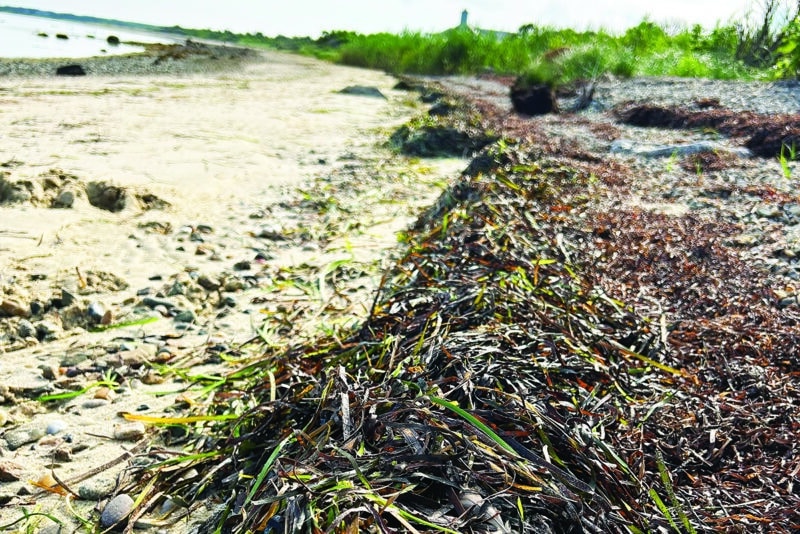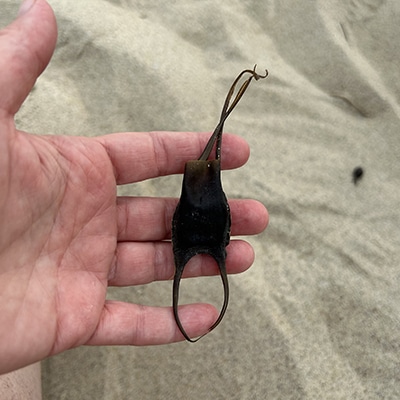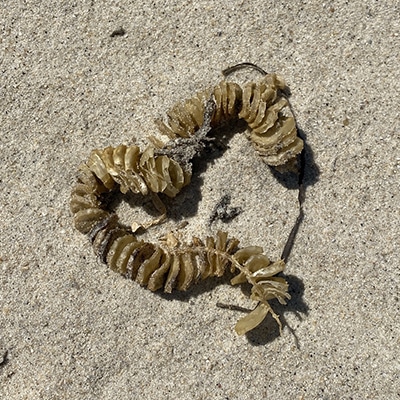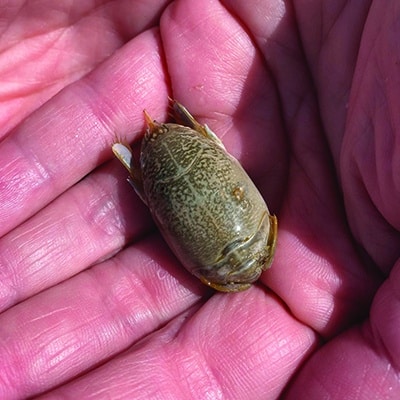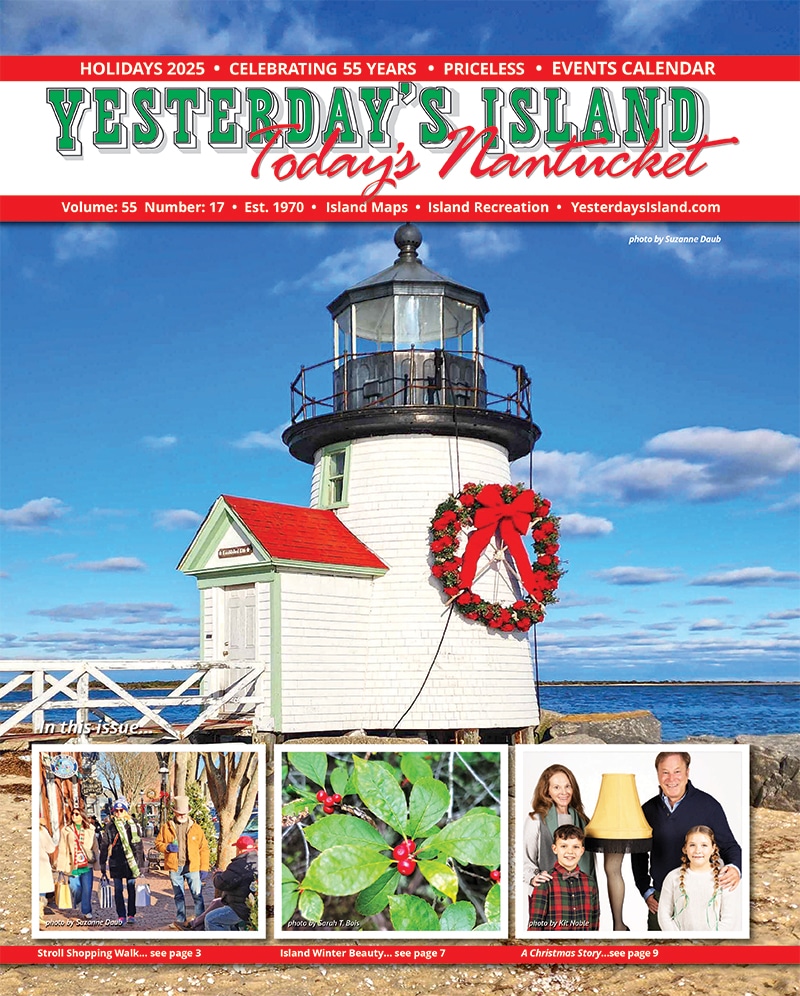by Dr. Sarah Treanor Bois, PhD
Director of Research & Education at the Linda Loring Nature Foundation
The past several days have been stunningly beautiful, though the hot and muggy weather forcing us to seek relief at the shoreline—well, forcing might be too strong a word. How about: it gave us an excuse to head to the beach to swim and play in the water. Whether on vacation, trying to occupy the kids, or just i need of a little salt water solace, many of us have escaped to the beach these past few weeks.
My beach-going recently has been for a dip to cool off, but also to see what I can find for the Nantucket BioBlitz. You can read more about the BioBlitz from a previous column (yesterdaysisland.com/join-the-blitz/). I was able to log in quite a few finds along both the north and south shorelines. What’s interesting about walking along the beach investigating the shore and the wrack line is that you’re more often looking for the remnants of something alive—a shell, a driedup piece of seaweed—but it’s still a biodiversity smorgasbord with clues for what is in the waters around Nantucket.
The wrack line is technically the area on the beach where organic material and other debris is deposited at high tide. Among the flotsam and jetsam of the wrack line, many treasures from the sea await. And occasionally a human-made treasure. Searching for sea glass is ever popular: my grandmother used to take us to beaches in Rhode Island when I was a little girl to find as many pieces of sea glass in as many colors as we could for her collection. Blues, greens, white, and the occasional purple—and the ever-elusive red glass. Today, however, recycling and a heightened sense of the problems caused by litter, have reduced sea glass to a rare find. When my son was small, his version of “sea glass” were shards of newly broken bottles. Now, we tend to bring a bag for trash to comb the beach. And, with recent undesirable wind farm detritus, a bag for debris (and potentially shoes to protect your feet) is a wise idea. Beyond sea glass or trash, the beach is littered with riches from the sea. Some are common, others rare, and most have some origin with a living thing. One thing is definitely true; none of it is boring!
Exploring north shore beaches and the harbor, there are plenty of areas for beachcombing. With shallow waters, low wave action, and big in-going and outgoing tides, the wrack lines of these beaches tend to leave more in the throng. You can generally tell the wrack line edge right off by the line of eel grass coiled parallel to the ocean. The discarded eel grass is actually a gift from the sea itself. Eel grass remnants make great mulch once rinsed off. Other sea weeds can also be mixed in with compost to add additional nutrients. It can help retain soil moisture and prevent weeds when used in garden beds to protect precious seedlings. At the end of the season, the mulch can be mixed into the soil for added nutrients.
Beyond the eel grass, or rather within the tangled coils of it on the beach, we can find other bits and bobs that we don’t need to harvest. The most common thing on north shore beaches are slipper shells. The common slipper shell (Crepidula fornicata) is a marine snail. About two inches or less in size, they can be gray, white, pink, or a combination. They are usually found stacked on top of each other when they wash ashore. When in a stack, the young on top are male, the bottom is female and the ones in the middle are hermaphrodites. The top males fertilize the slipper shell below and the sexes alternate back and forth to the bottom of the stack.
Sometimes called “Portuguese sweet meats,” slipper snails have been described as “poor man’s scallops.” To get at the meat, slide your finger underneath the muscle (foot) and pinch, pulling towards the wider end to free it from the shell. Rinse it in the sea, and you can eat it right on the beach to the delight of your fellow beach-goers.
Another shell I frequently encounter, especially at Dionis or Steps Beaches are mermaid toenails (aka jingle shells). These are the small, often translucent shells that can be shiny yellow, white, or pale orange. The jingle shell (Anomia simplex) is a common intertidal species found attached to rocks, other mollusks and arthropods. It cannot move once it is attached to a substrate.
These shells are great for children since they are often found with a small hole and can be easily strung onto an impromptu beach necklace. The holes are actually where the valve of the animal was located, but was left attached to the substrate when the shell came off.
Mermaid’s purses are another beach treasure. These rectangular horny “purses” are actually egg cases of skate (typically the little skate, Raja erinacea), a relative of sharks and rays. They are the most common skate in northern inshore waters, thus, their egg cases are plentiful on the beach. The egg cases are made of keratin, the same substance of which human fingernails are composed. An egg case forms around each individual skate embryo just before the mother deposits the cases on the sea floor. The long, curved projections on each corner of the egg tend to catch on seaweed or other objects, helping to anchor the egg case to the bottom. The horns serve to extract oxygen from the water and to release waste back into the water. The egg cases are very tough and hard to penetrate, deterring predators.
Initially the egg cases are waterproof because the embryos do not have gills until after three weeks of development. Then small holes open in the tips of the horns, admitting seawater, and the young skate learns to live as an underwater creature. When the time comes for the young skate to escape, the egg case splits open at one end and the youngster emerges.
One of the most common beach finds among the eel grass and seaweed is actually the egg case for the whelk snail. The snake-like structures are difficult to figure out at first. What creature could have made this thing? The long egg case (which can be up to 2 feet long) is made up of many quarter-sized chitinous egg cases. Each egg case (or capsule) holds numerous individual baby whelk. The shape of the capsule is specific to the type of whelk species, so you may be able to find more than one type. If the eggs haven’t hatched by the time you find them dried on the beach, you may be able to find some miniscule whelk shells inside.
Of course, there are many more shells and sea creatures to investigate. Using iNaturalist or a beach-comber guide, you can see what other people have found on the beach and what creatures they are or were from.
On the south shore, there are a few creatures that, because of the habitat, aren’t typically found along the north shore. Some of my chosen beaches to walk are Miacomet, Fisherman’s, and the beaches east or west of Cisco. A personal favorite of these areas is the mole crab (Emerita talpoida). They can be found at the shore alive and their shells are often in the wrack. The mole crab (also known as a sand crab or sand flea) is a small but mighty sea creature that lives just below the surface of the sand. If you’ve ever visited a beach on the East Coast, you most likely have encountered mole crabs without even knowing it. Perfectly camouflaged, if one is exposed by a wave, a person’s foot, or a child digging at the surf’s edge, it will dive back under the sand before you even know it’s there. They are the color of the sand and live mostly buried in the intertidal zone. Like other crabs, these little one-inch creatures have ten legs, but theirs are adapted for swimming and digging, not for walking or defense—they have no claws. When you see the tiny holes in the sand at the water’s edge, dig there and chances are you will find some buried mole crabs. My son and I used to dig them up and have “mole crab races” to see whose chosen crab would reach the water first. As a side note, they also make good bait for beach fishing.
There are so many other finds to explore: scallop and whelk shells, moon snails, razor clams, oysters, to name just a few. That doesn’t even count the multitude of seaweed species! You can make a scavenger hunt list for little ones you bring to the beach or, better yet, get out there and explore! You never know what you’re going to find.

